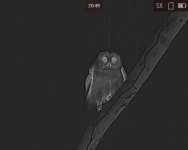abirdingguy
Well-known member
Thanks to everyone who has posted on this thread. Interesting information, and technology can be fun. My thoughts on the subject after some google searching are below. If anybody has experience or feedback on these ideas let me know.
In sticking with the topic of "equipment for mortals" and a general frugal approach, it seems that using existing equipment as much as possible could be a way to go. I don't need or want to pay for zoom and light-gathering optics or a display. I already have binoculars, a scope, and a smart phone to cover these functionalities. What is actually needed is the detector with good low light / IR / thermal sensitivity that with a little elbow grease, could be compatible with our existing equipment. I'm looking at this as analogous to where digi-scoping was a decade+ ago. As a mere mortal, I'm usually satisfied with my mid-range smartphone and spotting scope, especially if it saves 1,000s if not 10,000s of dollars on camera equipment. Could I be satisfied with "digi-scoping" with an IR sensor also?
Some options with my quick takes:
- A few smartphones such as the google pixel 4 have an NIR imaging sensor that can be accessed through some free apps in the google play store. Not many phones have this option, and it doesn't seem to be a trend to start including an IR imager as a feature. If I had such a phone, I would give it a try. The downside is that digiscoping adapters that work for the normal (vis) phone camera would need to account for the different sensor/lens location
- Phone and "regular" cameras have some sensitivity in the near IR, but they include a filter that reduces transmission in this spectrum. How about taking an old phone or camera (or a new one if you are brave) and removing the filter? This would be especially convenient one already has a scope adapter that works with the equipment. On the down side, I'm not sure how great the sensitivity would be, and this option involves carrying more gear into the field (e.g. your regular camera plus your altered IR camera).
- If you don’t want to implant the above suggestion yourself, this company will apparently do it for your phone and provide their custom software, for a decent markup of course: https://www.eigenimaging.com/collections/frontpagevis). As a frugal mortal, I’m not too excited to pay significant above original retail price for a phone that is a couple generations old. Also I’m more likely to take “normal” that “night-vision” pictures, so I wouldn’t want to impair my go-to camera – the one on my phone. There are IR filters that can be added back on, but to me, it’s not worth the price
- An option for both “night vision” and thermal imaging are the small IR sensors sold for scientific and industrial use. They are often made to be mounted to other equipment, which is convenient. There are a number of vendors offering these, but the potentially suitable ones I came across were either too expensive ($1000+) or did not list a price, which was the case most often. As the saying goes, if I have to ask, they are too expensive for me. If anyone is aware of some cheap options here, please let me know.
- A cheaper and more labor intensive option of the above is to buy board-level or perhaps even focal plane level components and construct your own camera. Beyond the optics and software challenges, building a suitably sturdy package and mount could also take some time, and at least for me, is less fun. We’ll see how stir crazy I go with the pandemic and how busy work keeps me, but I’m considering giving this option a try if I get bored enough this season.
- The final option is buying a consumer grade thermal sensing attachment for smartphones. The two brands that seem to be the best cheap option (sub $1000) are made by Seek Thermal and Flir. They both have a few models in the $250 - $500 that might do the trick. The main question here is how to mount them to your scope or binoculars. This may take a custom holder or perhaps a one-size-fits-all digiscoping adapter could be repurposed.
Thoughts or first hand experience anyone?
Probably not better late than never in this case, but here it goes anyway...
As others have pointed out, my post is short on good ideas (but long on words). I completely forgot that binocular/scope glass has little transmission at thermal wavelengths. Sorry about this.
The part about pixel 4 phones having the capability to take (a limited 640x480) NIR image is true though. Not sure if anybody tried using them with a scope and an IR emitter.









